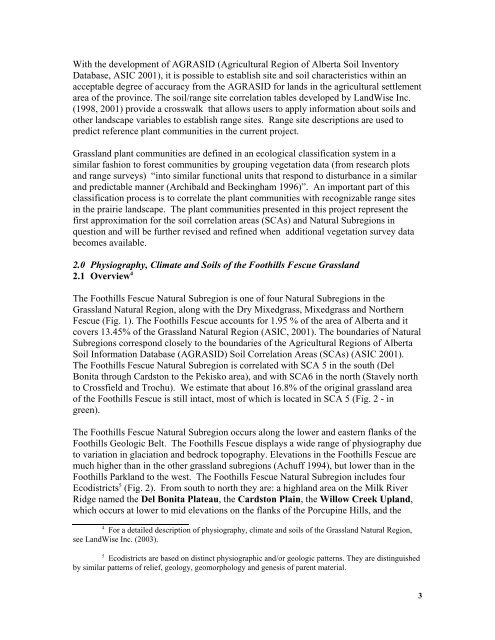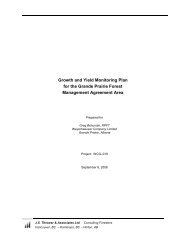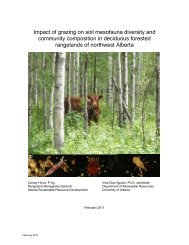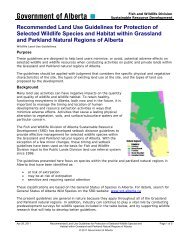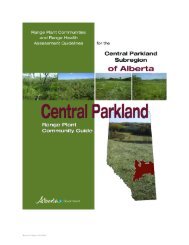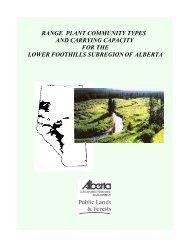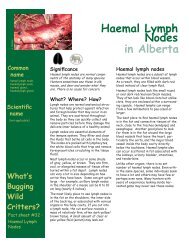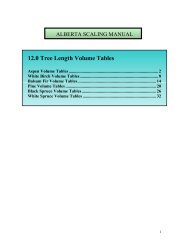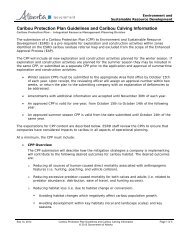Foothills Fescue Range Plant Community Guide - Sustainable ...
Foothills Fescue Range Plant Community Guide - Sustainable ...
Foothills Fescue Range Plant Community Guide - Sustainable ...
Create successful ePaper yourself
Turn your PDF publications into a flip-book with our unique Google optimized e-Paper software.
With the development of AGRASID (Agricultural Region of Alberta Soil Inventory<br />
Database, ASIC 2001), it is possible to establish site and soil characteristics within an<br />
acceptable degree of accuracy from the AGRASID for lands in the agricultural settlement<br />
area of the province. The soil/range site correlation tables developed by LandWise Inc.<br />
(1998, 2001) provide a crosswalk that allows users to apply information about soils and<br />
other landscape variables to establish range sites. <strong>Range</strong> site descriptions are used to<br />
predict reference plant communities in the current project.<br />
Grassland plant communities are defined in an ecological classification system in a<br />
similar fashion to forest communities by grouping vegetation data (from research plots<br />
and range surveys) “into similar functional units that respond to disturbance in a similar<br />
and predictable manner (Archibald and Beckingham 1996)”. An important part of this<br />
classification process is to correlate the plant communities with recognizable range sites<br />
in the prairie landscape. The plant communities presented in this project represent the<br />
first approximation for the soil correlation areas (SCAs) and Natural Subregions in<br />
question and will be further revised and refined when additional vegetation survey data<br />
becomes available.<br />
2.0 Physiography, Climate and Soils of the <strong>Foothills</strong> <strong>Fescue</strong> Grassland<br />
2.1 Overview 4<br />
The <strong>Foothills</strong> <strong>Fescue</strong> Natural Subregion is one of four Natural Subregions in the<br />
Grassland Natural Region, along with the Dry Mixedgrass, Mixedgrass and Northern<br />
<strong>Fescue</strong> (Fig. 1). The <strong>Foothills</strong> <strong>Fescue</strong> accounts for 1.95 % of the area of Alberta and it<br />
covers 13.45% of the Grassland Natural Region (ASIC, 2001). The boundaries of Natural<br />
Subregions correspond closely to the boundaries of the Agricultural Regions of Alberta<br />
Soil Information Database (AGRASID) Soil Correlation Areas (SCAs) (ASIC 2001).<br />
The <strong>Foothills</strong> <strong>Fescue</strong> Natural Subregion is correlated with SCA 5 in the south (Del<br />
Bonita through Cardston to the Pekisko area), and with SCA6 in the north (Stavely north<br />
to Crossfield and Trochu). We estimate that about 16.8% of the original grassland area<br />
of the <strong>Foothills</strong> <strong>Fescue</strong> is still intact, most of which is located in SCA 5 (Fig. 2 - in<br />
green).<br />
The <strong>Foothills</strong> <strong>Fescue</strong> Natural Subregion occurs along the lower and eastern flanks of the<br />
<strong>Foothills</strong> Geologic Belt. The <strong>Foothills</strong> <strong>Fescue</strong> displays a wide range of physiography due<br />
to variation in glaciation and bedrock topography. Elevations in the <strong>Foothills</strong> <strong>Fescue</strong> are<br />
much higher than in the other grassland subregions (Achuff 1994), but lower than in the<br />
<strong>Foothills</strong> Parkland to the west. The <strong>Foothills</strong> <strong>Fescue</strong> Natural Subregion includes four<br />
Ecodistricts 5 (Fig. 2). From south to north they are: a highland area on the Milk River<br />
Ridge named the Del Bonita Plateau, the Cardston Plain, the Willow Creek Upland,<br />
which occurs at lower to mid elevations on the flanks of the Porcupine Hills, and the<br />
4<br />
For a detailed description of physiography, climate and soils of the Grassland Natural Region,<br />
see LandWise Inc. (2003).<br />
5 Ecodistricts are based on distinct physiographic and/or geologic patterns. They are distinguished<br />
by similar patterns of relief, geology, geomorphology and genesis of parent material.<br />
3


